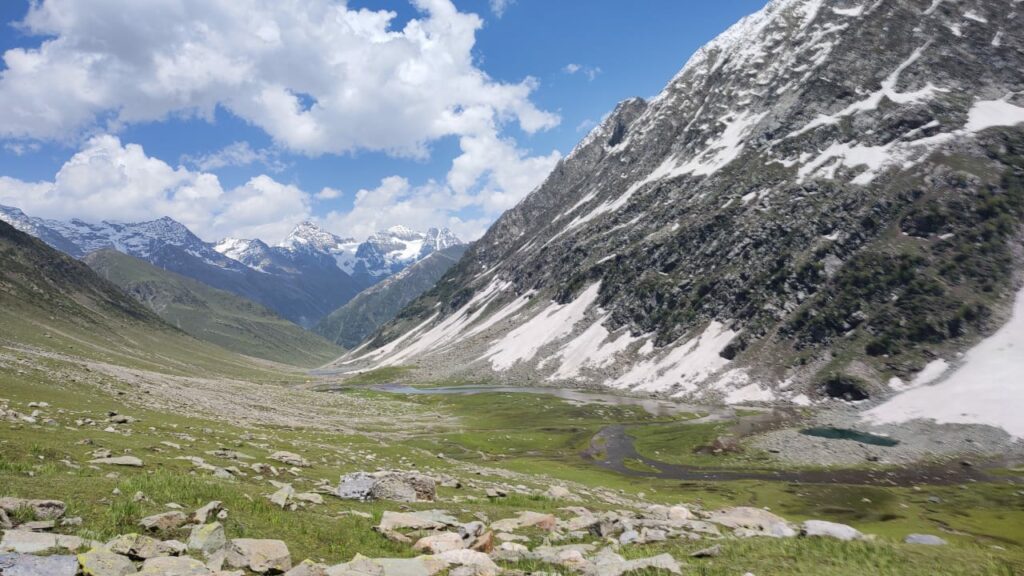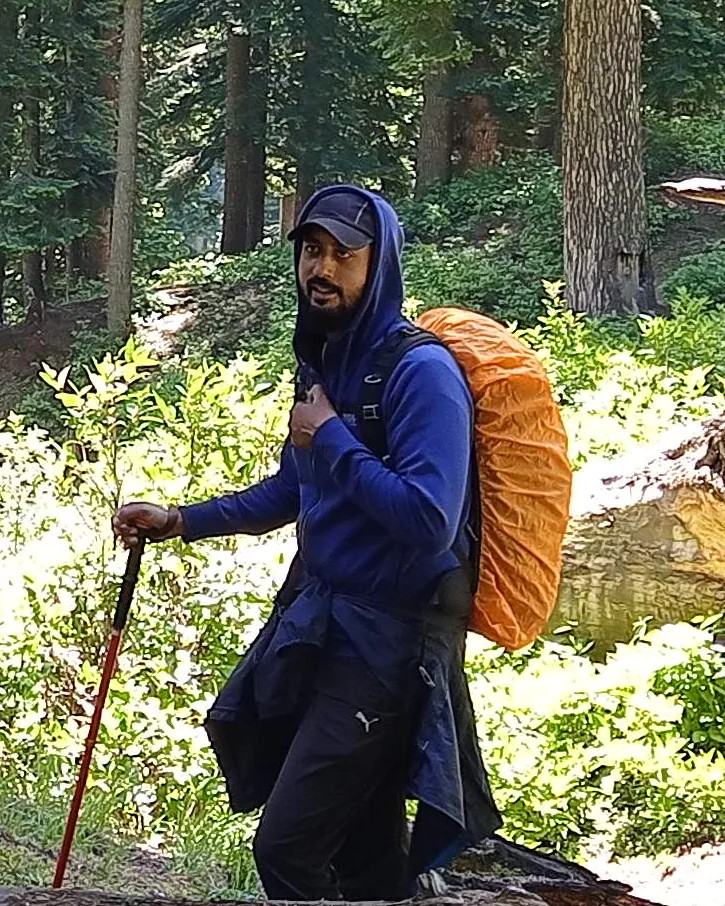Kolahoi Glacier Trek
Trek duration
5 nights 6 days
Total Distance
18 kilometres
Difficulty Level
Moderate - Extreme
14,500/person
Including all Taxes
Trek duration
5 nights 6 days
Total Distance
18 kilometres
Difficulty Level
Intermediate
14,500/person
Including all Taxes
Kolahoi glacier Trek
A difficult and demanding trip across the breathtaking vistas of the Kashmir valley in India is the Kolahoi Glacier Trek. The walk begins in the charming hill town of Pahalgam and goes through pine, fir, and deodar forests as well as the raging Lidder River. The spectacular Kolahoi Glacier, which is situated at a height of 18,000 feet above sea level, can then be reached by following the trail. Awe-inspiring views of the surrounding mountains, including the Kolahoi Peak, the highest point in the area, may be had from the glacier. Excellent physical condition and previous high altitude trekking experience are prerequisites for the trek. The trek offers a unique experience to explore the beauty of the Himalayas and is a must-do for all adventure enthusiasts.
What's included

Logistics & Support
Professional hosts and logistics like carriage horses to carry all the heavy load to keep you light on the trail.
Equipments
All camping equipments like tents, toilet tents, sleeping bags, walking sticks, rain ponchos, tent lights etc.
Food & Beverages
Breakfast, lunch and dinner plus few tea sessions to keep you up and active on the trails or warm on a cold night alongside the Lake.
Food & Beverages
Transport facilities will be provided from Srinagar to Aru and return to srinagar
Detailed itinerary
Day 1: Srinagar to Aru
The hike begins at Aru village. We will start our tour in Srinagar and drive around 115 kilometres to Aru. When you arrive at the appropriate pick-up location, one of our staff will meet you and transport you to Aru. We will drive from Srinagar to Pahalgam, which is 100 kilometres away, and Aru hamlet, which is 12 kilometres away from Pahalgam.
Aru is a moderately established tourist destination located on the Lidder River’s bank, and it also serves as the base camp for the popular Tarsar Marsar Trek and the Kolahoi Glacier Trek. In the winter, it is also a centre for adventure activities such as horseback riding and heliskiing. Trout fishing on the Lidder River is another popular activity in the area. Because network connections in Aru are not particularly steady and not all network connections operate, you must have all of your communications wrapped up in Pahalgam. We will be camping in Aru, and our campground is in a magnificent setting by the Lidder River.
Day 2: Aru to Lidderwat
The trek begins in Aru and takes you through an 11-kilometer, gentle ascent towards Lidderwat, which becomes our camping site for the night. Lidderwat is a beautiful meadow with two gushing rivers, one flowing from Satlanjan, a confluence of seven glacial streams, and the other from Tarsar, both converging at the base of this beautiful camping spot. Lidderwat is also a heaven for stargazing, as on a clear night you can divulge into the vastness of our galaxy like never before.
Day 3: Lidderwat to Satlanjan
The third day’s trip is comparatively more difficult. You pass the milky-white Dudhsar stream as you walk. You must walk carefully on this section of the hike because stones and gravel are strewn over the entire path. Mountains tower over you on both sides as you stroll down the stream, and you walk where they meet the ground. One of the prominent places along the route is Susrin, which is barely 0.5 kilometres from Satlanjan. We move through stones, over streams, and through valleys as we walk. To avoid hurting yourself, proceed cautiously past the rocks. Chainbal waterfall is one amazing thing you’ll see on the third day. It seems as if it is coming straight out of the clouds due to the height from which it falls. After walking for some more minutes, you will reach Satlanjan.
Day 4: Satlanjan to Kolahoi Glacier
We drop a bit into the valley, then go straight through to the Kolahoi Glacier Viewpoint. At 11,000 feet, this is the closest you can get to this huge glacier. This glacier is also known as the Kashmir Matterhorn. It is a reliable supply of water for the Kashmiris and the Jhelum River. Kolahoi Glacier is a five-kilometer-long hanging glacier. It’s dangerous to come too near since the snow may be hollow below. It is recommended that you pay close attention to the trek leaders’ instructions. The campsite is located near the Kolahoi Glacier. Have a great day camping near the gigantic glacier.
Day 5: Kolahoi Glacier to Satlanjan
The trail leads back to Satlanjan from the Kolahoi campground. The trail is once more lined with rocks and boulders before entering a meadow. To get to Satlanjan from the meadows, it is a short hike, and you will reach the campsite in 3 to 4 hours. Relax in the pleasant and luring beauty of this valley, where we will camp overnight.
Day 6: Satlanjan to Aru
The longest day of the entire journey is today. The trail does not, however, provide many difficulties. You will be walking through wide-open, forested valleys while traversing lush grasslands. It is always a relief that the path is graced with mountain streams. The milky white stream’s water is energising and clean. Today, it’s crucial that you take frequent breaks of five minutes each and stay hydrated. If you don’t time yourself properly, lowering 2492 feet of height in one day might be challenging. It is primarily a gradual climb. If you leave early, you’ll get to Aru no later than 2 o’clock.
Essential Requirements
- Proper hiking boots with good grip and ankle support
- Lightweight and moisture-wicking clothing suitable for trekking
- Warm layers such as a fleece jacket and a down jacket for chilly nights
- Waterproof and windproof jacket and pants
- Sun hat and sunglasses
- Sunscreen and lip balm with SPF
- Insect repellent
- Headlamp or flashlight with extra batteries
- Trekking poles for stability on uneven terrain
Health Requirements
- A healthy resting pulse rate should fall within the range of 60 to 90 beats per minute.
- The ideal blood pressure range at rest is between 75-85 for diastolic and 100-130 mm Hg for systolic.
- A normal resting respiratory rate is between 12 to 20 breaths per minute.
- The absence of conditions such as Diabetes Mellitus, Bronchial Asthma, Epilepsy, Heart Problems, Very High Blood Pressure, and other illnesses is desirable.
- There should be no issues with liver or kidney function.
- It is preferable not to have a pacemaker implant.
Expert
Opinion
Farhan Hussain Mas’udi
CEO, InterExperia

As an experienced trekker and founder of InterExperia, a trekking travel agency in Kashmir, I highly recommend trekking in this region. Kashmir offers a diverse range of trekking routes that cater to all levels of experience and fitness.Some of the popular trekking routes in Kashmir include the Great Lakes Trek, Tarsar Marsar Trek, and Kashmir Alpine Lakes Trek. These treks offer breathtaking views of snow-capped mountains, alpine meadows, and pristine lakes.It’s important to note that Kashmir is a high-altitude region, and proper acclimatization is necessary to avoid altitude sickness. We recommend spending a few days in Srinagar or other lower altitude areas before starting the trek.Additionally, it’s essential to be well-equipped for the trek, including proper clothing, footwear, and trekking gear. It’s also crucial to have a knowledgeable guide who is familiar with the terrain and can provide necessary support during the trek.
Overall, trekking in Kashmir is an incredible experience that allows you to connect with nature and explore the beauty of this region. At InterExperia, we strive to provide our clients with a safe and memorable trekking experience in Kashmir.


